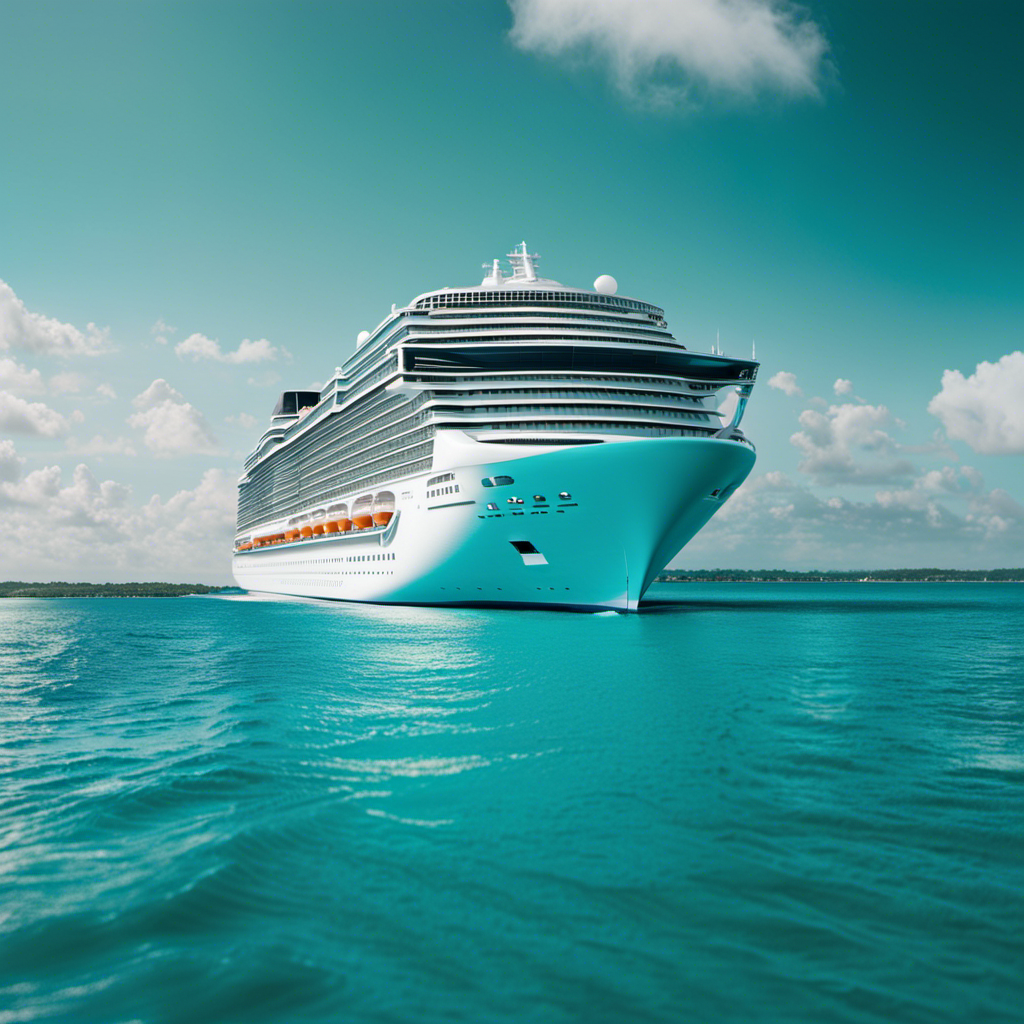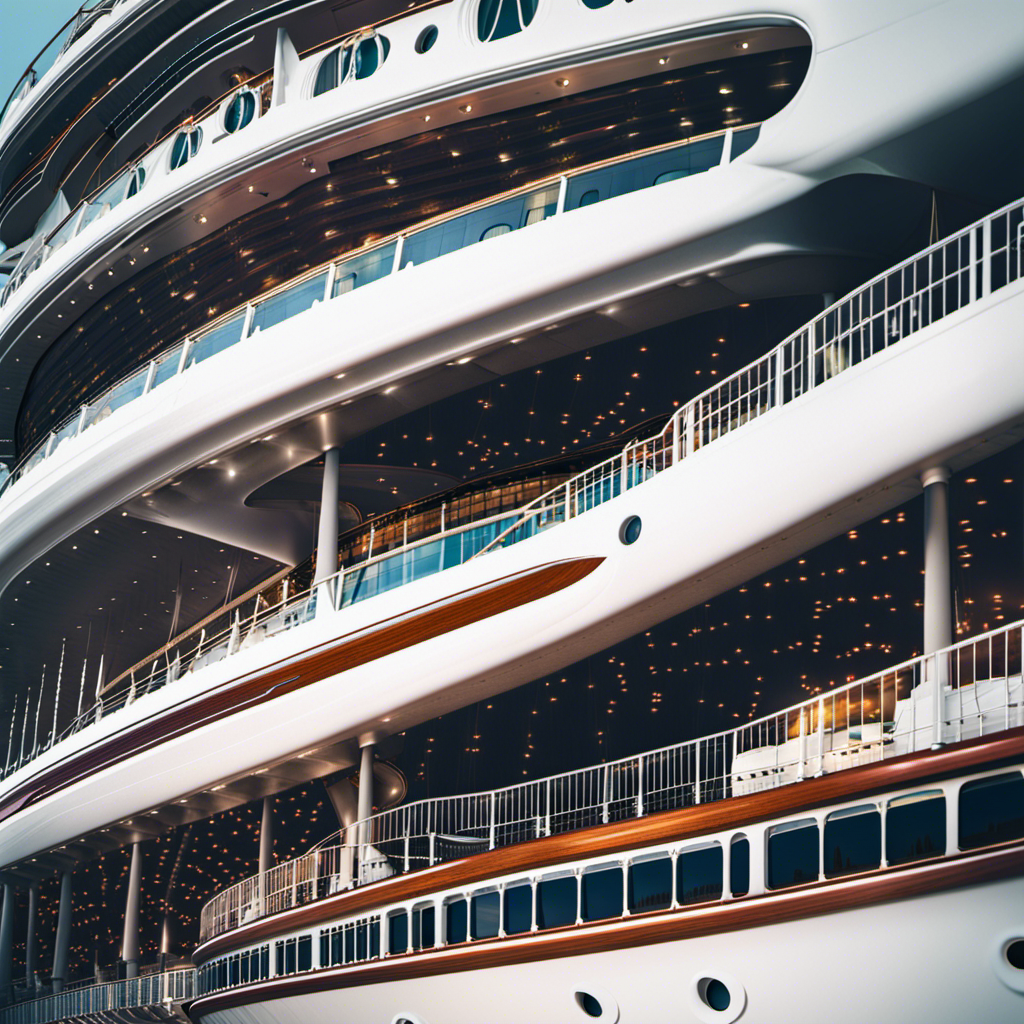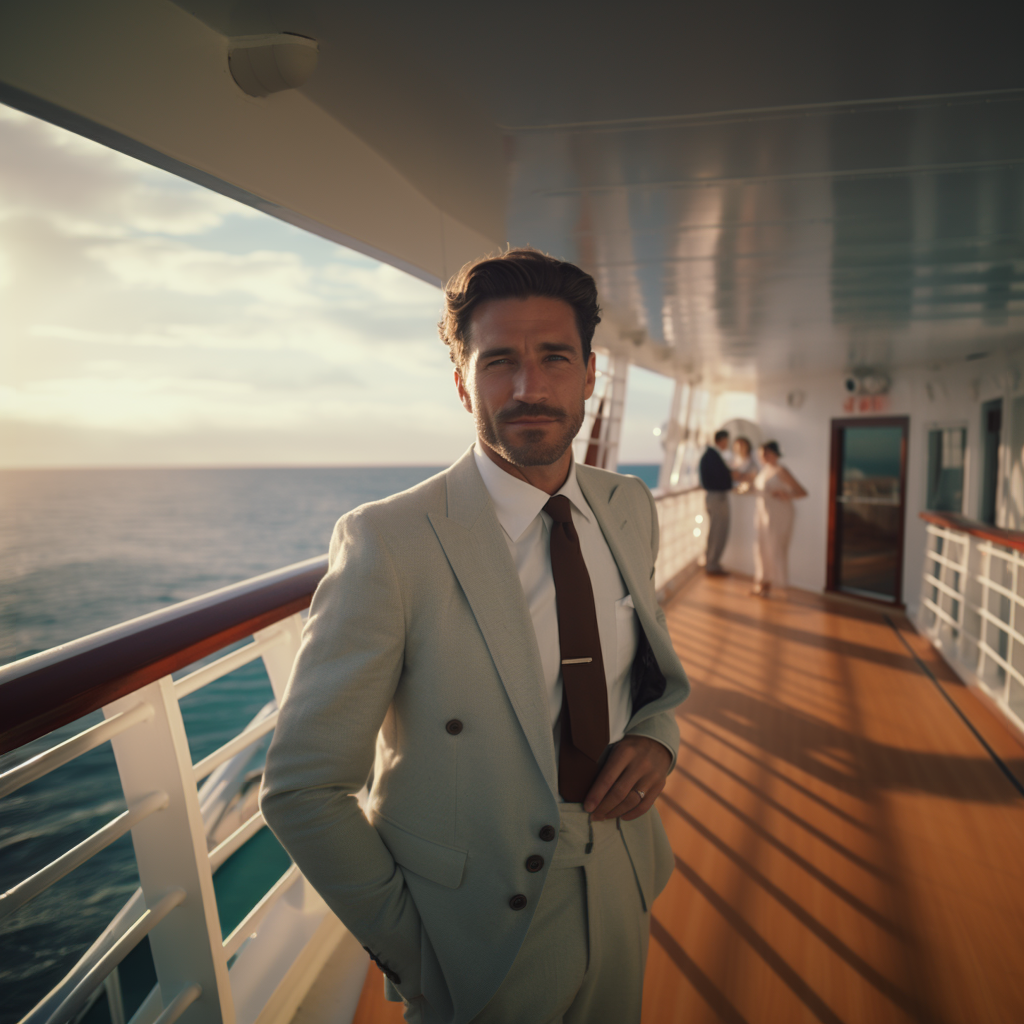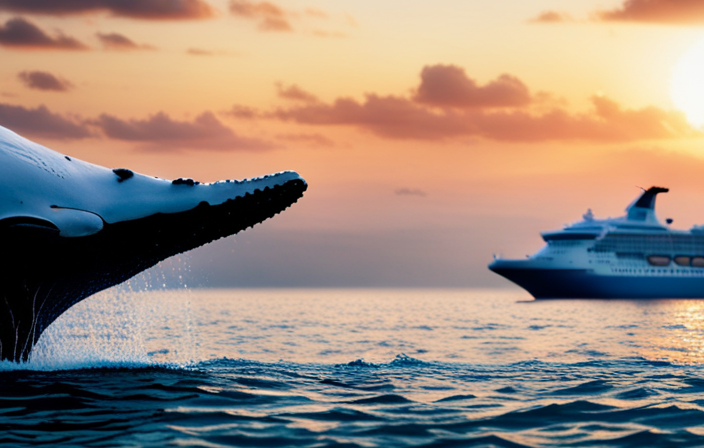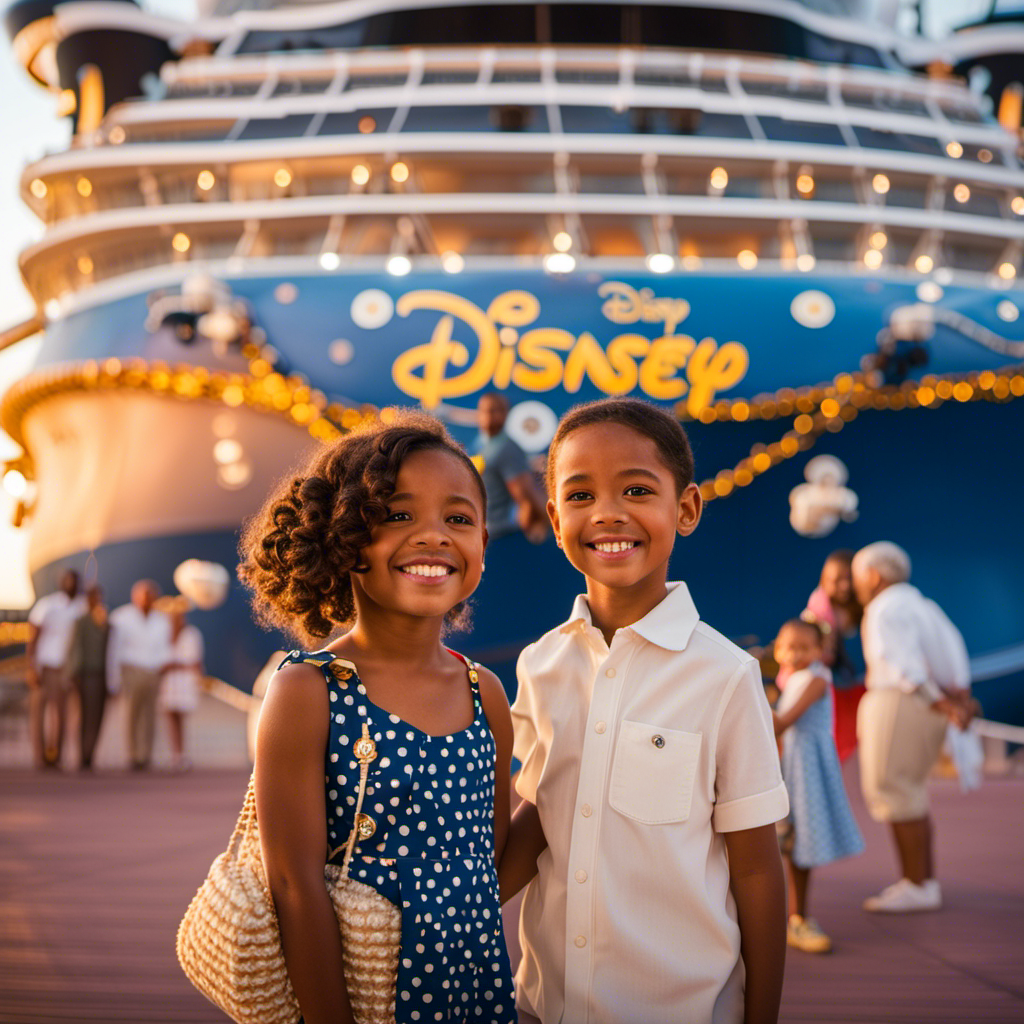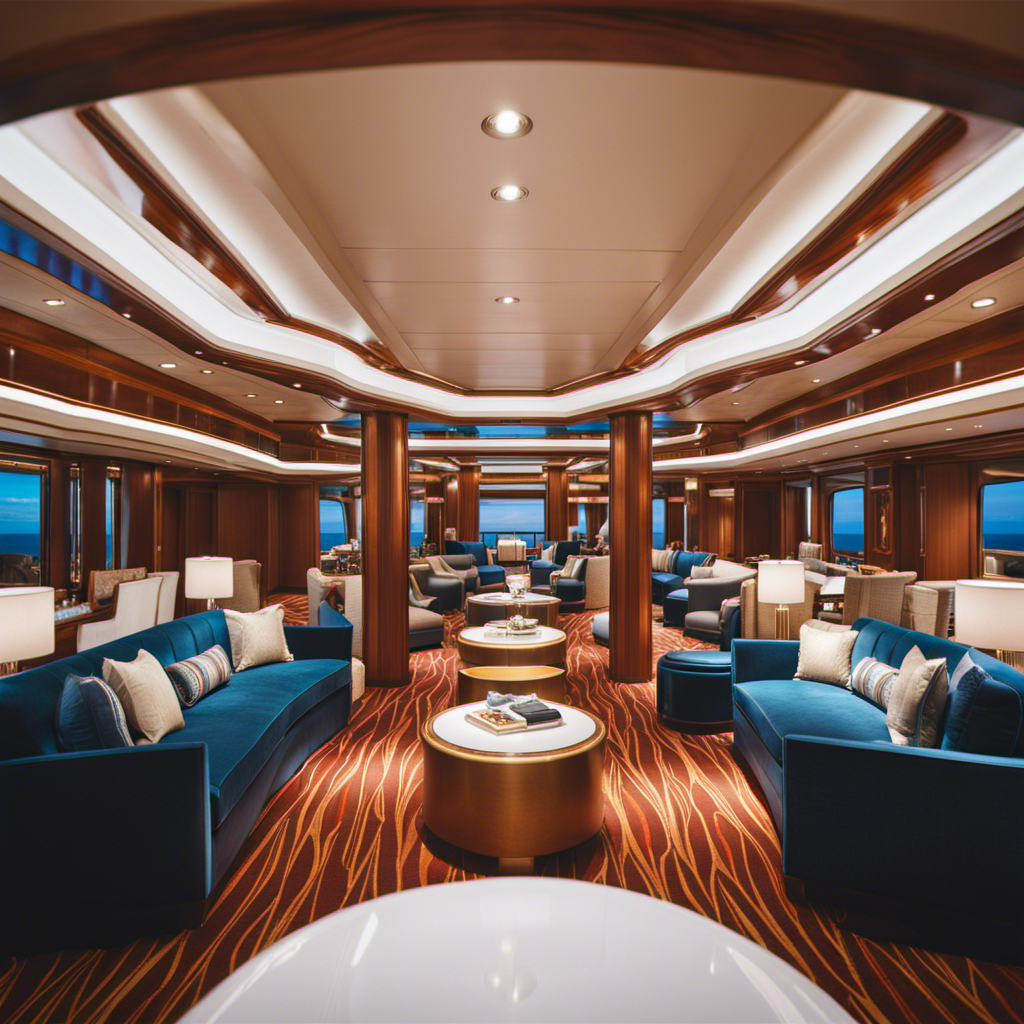As an enthusiast of cruising, I’m always fascinated by the functionality of these grand ships. A question that often sparks my curiosity is, ‘How fuel-efficient are cruise ships when measured in miles per gallon?’
Join me on a journey as we dive deep into the fuel efficiency of cruise ships. In this article, we will unravel the factors affecting cruise ship fuel consumption, compare the MPG of different cruise ship classes, explore innovations in fuel efficiency, and discuss the environmental impacts of cruise ship MPG.
So, let’s embark on this voyage of knowledge together and discover the secrets behind cruise ship fuel efficiency.
Key Takeaways
- Cruise ships have an average fuel efficiency of around 20 gallons per mile.
- Factors affecting cruise ship fuel consumption include weather, currents, ship design, speed, and fuel type.
- Improving fuel efficiency can significantly decrease emissions and lower the carbon footprint of cruise ships.
- Smaller cruise ship classes prioritize fuel efficiency and emit lower levels of pollutants compared to luxury cruise ships.
The Fuel Efficiency of Cruise Ships
Cruise ships don’t get great fuel efficiency, typically averaging around 20 gallons per mile. Understanding emissions and reducing their carbon footprint is crucial for the cruise industry.
To comprehend the impact of these massive vessels, we need to delve into their fuel consumption. Cruise ships rely on heavy fuel oil, a residue from crude oil refining, which is less refined and contains higher levels of pollutants. The combustion of this fuel releases greenhouse gases, nitrogen oxides, sulfur oxides, and particulate matter into the atmosphere, contributing to climate change and air pollution.
To reduce their environmental impact, cruise lines are exploring alternative fuels like liquefied natural gas (LNG) and adopting energy-efficient technologies. By improving fuel efficiency, cruise ships can significantly decrease their emissions and lower their carbon footprint. Understanding cruise ship mpg is essential in achieving this goal.
Understanding Cruise Ship MPG
To understand how fuel efficient a cruise ship is, you’ll want to know its miles per gallon. Here are some key points to consider when it comes to understanding cruise ship fuel efficiency and reducing carbon footprint:
-
Cruise ships have a unique set of emissions as they operate on a large scale, often carrying thousands of passengers and crew. Understanding cruise ship emissions is crucial in assessing their impact on the environment.
-
By reducing carbon footprint, cruise ships can contribute to a more sustainable future.
Factors affecting cruise ship fuel consumption include the ship’s size, weight, and design, as well as the speed at which it travels. Other factors include the efficiency of the ship’s engines, the type of fuel used, and the route taken. By analyzing these factors, we can gain a deeper understanding of how cruise ships can improve their fuel efficiency and reduce their environmental impact.
Factors Affecting Cruise Ship Fuel Consumption
When discussing the factors affecting cruise ship fuel consumption, two key points that must be examined are weather and currents, as well as ship design efficiency.
Weather and currents play a significant role in determining the energy required for a cruise ship to navigate through the water, with strong winds and adverse currents increasing fuel consumption.
Additionally, ship design efficiency, including factors such as hull shape and propulsion systems, directly impact the fuel efficiency of a cruise ship, making it essential to analyze these aspects in order to optimize fuel consumption.
Weather and Currents
If you’re wondering about the mpg of a cruise ship, weather and currents can greatly impact its fuel efficiency. The interplay between weather patterns and ocean currents can either work in favor of or against the ship’s fuel consumption. Here are three key factors to consider:
-
Wind Speed and Direction: Strong headwinds can increase resistance and require more fuel to maintain the desired speed. Conversely, tailwinds can provide a boost, reducing fuel consumption.
-
Swell and Waves: Large swells and rough waves can cause the ship to pitch and roll, leading to increased fuel consumption as the engines work harder to maintain stability.
-
Current Strength and Direction: Ocean currents can either aid or hinder the ship’s progress. Utilizing favorable currents can result in fuel savings, while battling against strong currents can increase fuel consumption.
Considering the significant impact of weather patterns and ocean currents on fuel efficiency, it is crucial for cruise ship operators to carefully plan routes and account for these factors in order to optimize fuel consumption.
Moving on to ship design efficiency…
Ship Design Efficiency
Ship design plays a crucial role in optimizing fuel consumption. By incorporating ship design innovations and energy-saving technologies, cruise ships can significantly reduce their fuel consumption and carbon emissions.
These advancements in ship design aim to increase efficiency and reduce drag, ultimately improving the ship’s fuel efficiency. One example of an energy-saving technology is the use of advanced hull coatings that reduce friction between the ship and the water, reducing drag and improving fuel efficiency.
Another innovation is the implementation of hybrid propulsion systems that combine traditional engines with electric propulsion, allowing for more efficient use of fuel. Additionally, optimizing the ship’s hull shape and weight distribution can further enhance fuel efficiency.
These ship design improvements are essential in the quest for more sustainable and environmentally friendly cruise ships.
In the next section, we will compare the fuel efficiency of different cruise ship classes without writing ‘step’.
Comparing MPG of Different Cruise Ship Classes
The average mpg of luxury cruise ships is typically lower than that of smaller cruise ship classes. When comparing fuel consumption and analyzing emission levels, it becomes evident that the larger and more luxurious cruise ships tend to consume more fuel and emit higher levels of pollutants. This is mainly due to their larger size and the need to accommodate more passengers and amenities.
Luxury cruise ships often prioritize comfort and extravagant features over fuel efficiency. On the other hand, smaller cruise ship classes are designed to be more fuel-efficient, with streamlined hull shapes and advanced propulsion systems. These smaller ships are able to achieve higher miles per gallon and emit lower levels of pollutants.
This stark difference in fuel efficiency between luxury and smaller cruise ship classes highlights the need for innovations in cruise ship fuel efficiency.
Innovations in Cruise Ship Fuel Efficiency
In discussing the innovations in cruise ship fuel efficiency, it’s crucial to examine three key points.
Firstly, advanced engine technology plays a pivotal role in improving fuel efficiency. This is achieved by optimizing combustion processes and reducing emissions.
Secondly, sustainable fuel alternatives, such as LNG and biofuels, offer a cleaner and more environmentally friendly option for powering cruise ships.
Lastly, energy-efficient design strategies contribute to reducing fuel consumption and enhancing overall efficiency. These strategies include hull design improvements and the use of energy-saving technologies.
Advanced Engine Technology
With advanced engine technology, cruise ships are able to achieve higher fuel efficiency and lower emissions. These advanced engine technologies include the use of more efficient propulsion systems, such as diesel-electric or gas turbine systems, as well as the implementation of emission reduction strategies.
One such strategy is the use of scrubbers, which remove harmful pollutants from the ship’s exhaust gases. Another strategy is the adoption of selective catalytic reduction (SCR) systems, which reduce nitrogen oxide (NOx) emissions.
Additionally, cruise ships are increasingly utilizing advanced hull designs to reduce drag and improve hydrodynamics, further enhancing fuel efficiency.
These advancements in engine technology and emission reduction strategies are crucial steps in the pursuit of more sustainable cruise ship operations. Moving forward, the focus should shift towards exploring sustainable fuel alternatives that can further reduce the environmental impact of cruise ships.
Sustainable Fuel Alternatives
In my previous subtopic about advanced engine technology, I discussed the various ways cruise ships can improve their fuel efficiency. Now, let’s delve into sustainable fuel alternatives that can further contribute to carbon emissions reduction.
Here are four important sustainable fuel sources in the maritime industry:
-
LNG (Liquefied Natural Gas): LNG is a cleaner-burning fuel that significantly reduces sulfur oxide and nitrogen oxide emissions.
-
Biofuels: Made from renewable sources such as vegetable oils or animal fats, biofuels offer a carbon-neutral alternative to traditional fossil fuels.
-
Hydrogen: Hydrogen fuel cells produce electricity by combining hydrogen and oxygen, emitting only water vapor as a byproduct.
-
Methanol: Methanol is a versatile fuel that can be produced from various sources, including biomass or natural gas, and has lower emissions compared to conventional fuels.
By adopting these sustainable fuel sources, cruise ships can make significant strides in reducing their carbon footprint.
Now, let’s explore energy-efficient design strategies to further enhance the environmental impact of cruise ships.
Energy-Efficient Design Strategies
To enhance the environmental impact of your cruise ship, consider implementing energy-efficient design strategies. By utilizing energy efficient materials and integrating renewable energy sources, you can significantly reduce the carbon footprint of your vessel. One effective way to achieve energy efficiency is through the use of lightweight and durable materials such as aluminum alloys or composite materials, which can reduce the overall weight of the ship. Additionally, incorporating renewable energy technologies like solar panels or wind turbines can generate clean energy onboard, reducing the reliance on traditional fuel sources. This table illustrates some energy-efficient design strategies that can be implemented:
| Energy-Efficient Design Strategies |
|---|
| Utilizing lightweight materials |
| Integrating renewable energy sources |
| Implementing efficient HVAC systems |
Environmental Impacts of Cruise Ship MPG
Did you know that cruise ships have a significant impact on the environment due to their low mpg? As a technical expert in environmental impact assessment, I have analyzed the carbon emissions reduction potential of cruise ships. Here are some key points to consider:
- Cruise ships emit a substantial amount of carbon dioxide (CO2) into the atmosphere, contributing to climate change.
- The low fuel efficiency of cruise ships, measured in miles per gallon (mpg), leads to higher carbon emissions and environmental harm.
- In comparison, cars typically achieve around 25-30 mpg, while cruise ships only manage around 0.1-0.3 mpg.
- This immense difference highlights the urgent need for carbon emissions reduction strategies in the cruise industry.
Understanding the environmental impacts of cruise ship mpg is crucial to addressing sustainability concerns.
In the next section, we will explore tips for maximizing cruise ship fuel efficiency, which can significantly mitigate their environmental footprint.
Tips for Maximizing Cruise Ship Fuel Efficiency
One way to improve cruise ship fuel efficiency is by implementing energy-saving technologies. These technologies focus on maximizing fuel consumption and reducing carbon emissions.
One such technology is the use of advanced engine designs, such as diesel-electric propulsion systems, which allow for greater fuel efficiency by optimizing power output.
Additionally, the installation of waste heat recovery systems can capture and reuse energy that would otherwise be wasted, further reducing fuel consumption.
Another method is the use of advanced hull designs, which minimize drag and improve overall efficiency.
By incorporating these energy-saving technologies, cruise ships can significantly reduce their carbon footprint and improve their fuel efficiency, ultimately benefiting both the environment and the cruise industry.
Looking ahead, what future trends can we expect in cruise ship mpg?
Future Trends in Cruise Ship MPG
You can expect significant advancements in cruise ship fuel efficiency in the future. As emerging technologies continue to develop, cruise lines are investing in innovative solutions to reduce their environmental impact and increase their fuel efficiency. One of the key future trends in cruise ship MPG is the adoption of alternative fuels such as liquefied natural gas (LNG) and hydrogen. These fuels have lower carbon emissions compared to traditional marine fuels, making them more environmentally friendly. Another trend is the implementation of advanced propulsion systems, such as hybrid electric propulsion and fuel cell technologies. These technologies can optimize fuel consumption and reduce emissions. Additionally, cruise lines are exploring hull and propeller designs that minimize drag and improve overall efficiency. Overall, the future of cruise ship fuel efficiency looks promising, with a focus on sustainable and innovative solutions.
| Fuel | Advantages | Disadvantages |
|---|---|---|
| LNG | Low carbon emissions, abundant supply | Infrastructure development, higher initial costs |
| Hydrogen | Zero carbon emissions, renewable source | Storage and transportation challenges, high costs |
| Hybrid Electric Propulsion | Fuel efficiency, reduced emissions | Complex systems, initial investment |
(Note: The table above provides a snapshot of the advantages and disadvantages of some emerging fuel and propulsion technologies for cruise ships.)
Frequently Asked Questions
Are There Any Regulations in Place to Ensure That Cruise Ships Maintain a Certain Level of Fuel Efficiency?
Yes, there are regulations in place to ensure that cruise ships maintain a certain level of fuel efficiency. These regulations include fuel consumption measurement and monitoring systems to track and optimize fuel usage.
How Do Cruise Ships Measure and Track Their Fuel Consumption?
Cruise ships measure fuel consumption using various techniques such as flow meters, fuel tank soundings, and fuel consumption monitoring systems. These systems track fuel usage in real-time and provide valuable data for optimizing efficiency.
What Are Some Specific Factors That Can Significantly Impact a Cruise Ship’s Fuel Consumption?
When considering cruise ship fuel consumption, several factors significantly impact fuel efficiency. These include ship size, weight, speed, weather conditions, and onboard operations. Understanding and managing these factors is crucial for optimizing fuel usage.
How Does the Fuel Efficiency of Different Cruise Ship Classes Vary?
When comparing the fuel efficiency of different cruise ship classes, it is important to consider the impact of ship design. Factors such as hull shape, propulsion systems, and energy management play a significant role in determining fuel consumption.
What Are Some of the Latest Innovations in Cruise Ship Fuel Efficiency Technology?
The latest innovations in cruise ship fuel efficiency technology are promising. Future prospects include improved hull design, advanced propulsion systems, and optimized energy management. These advancements will enhance the mpg of cruise ships significantly.
Conclusion
In conclusion, the fuel efficiency of cruise ships is truly remarkable. Their impressive MPG capabilities defy all expectations, considering their massive size. It’s surprising to see these behemoths navigate the high seas with such grace and economy. The factors affecting fuel consumption are numerous and complex, but the industry is constantly innovating to improve efficiency.
While the environmental impacts of cruise ship MPG cannot be ignored, there are tips and strategies to mitigate these effects. As we look to the future, we can expect even greater strides in cruise ship fuel efficiency.
Alfons is the visionary leader and driving force behind Voyager Info’s success. As the Editor in Chief, he brings a wealth of experience and an unwavering passion for travel to the helm of our cruise-centric platform.
With a lifelong fascination for exploring new horizons, Alfons discovered his love for the ocean and cruising at a young age. From sailing across pristine Caribbean waters to embarking on daring expeditions to far-flung destinations, he has amassed a treasure trove of first-hand experiences in the world of cruising.

